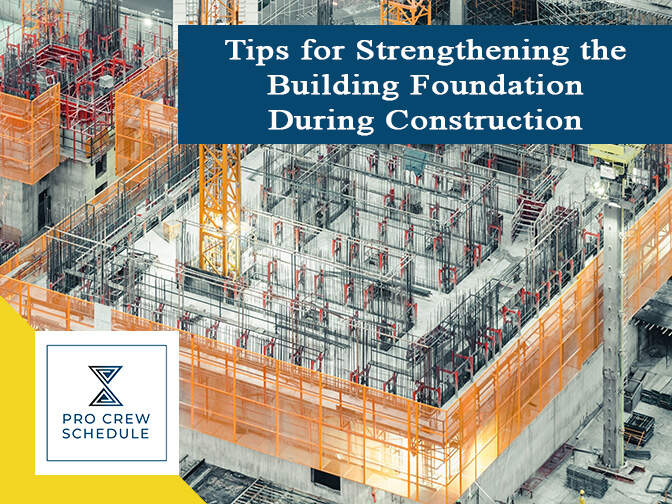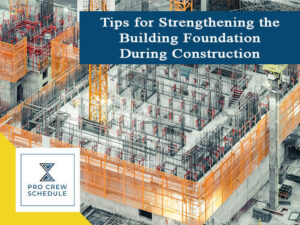The foundation is an essential component of any building project, most notably in skyscrapers. It keeps a structure upright and is one of the primary sources of strength of the building. Constructing it with substandard quality can put many lives at risk, if not the construction crew, the building occupants will be in danger. Hence, in managing construction projects, both the project manager and the concrete contractor should look into ways to improve the building’s foundation’s quality and strength.
Purpose of Building Foundation
As we just mentioned, the foundation keeps the structure upright, but it actually does more than that. It keeps the ground it’s standing on firmer so that the building resists elements that can damage the structure like moisture and movement. Furthermore, the building foundation insulates the ground to keep occupants feeling cozier under a cold, U.S. weather.
A good foundation is then a must in all buildings. And to ensure that it is of high quality, concrete contractors usually reinforce the foundation walls and concrete footing with steel. By doing so, the foundation becomes more able to support an entire building load and keep the occupants safe from acts of nature like earthquakes, strong winds, and floods.
Finally, a well-concreted foundation can keep the moisture out, which can significantly weaken the building’s overall strength.
Components of a Good Building Foundation
Construction engineers advise licensed contractors to be more watchful when it comes to constructing the building foundation. The strength should be computed so that it can support both “dead” (weight of the structure) and “live” (occupants and other objects) loads. The primary role of the foundation is to channel these loads to the ground. Constructing a building on a sloping or moist ground poses more challenges to the project team as the foundation strength’s computation is different. The foundation in those locations needs to be customized and strictly durable.
Experts suggest using steel reinforcement to enhance the foundation’s strength and see to it that the walls and footings are properly dried and cured. We have a previous blog on how concrete strength can be improved through proper drying.
Constructing Building Foundations
Building foundations start with digging holes and pouring cement, but building a good one requires more than that. Earlier in the construction phase, building foundation actually begins with inspecting and testing the soil, computing loads, and designing the best foundation setup to sustain soil and load conditions. The water tables and backfill quality should also be looked into.
Every detail in building the foundation must be perfect. This is why licensed contractors always work with their concreting subcontractors as early as the pre-construction phase. They plan and design the foundation together because the success of the building is much dependent on it. They test the design on BIM, identify problems, revise the design, develop the final plan, and document them on project management software. Neglect one of these steps and the building foundation may fail.
Strengthening Building Foundations
Now that you’ve learned the importance of the foundation and the basics of constructing a good one, let’s now look into some tips on strengthening it further.
1. Always Start with Soil Inspection
There’s no sense in procuring the best cement and reinforcement materials if the soil where they will be laid down isn’t tested. So in managing the construction of good foundations, the first step is always soil testing.
The type and condition of the soil where the building will be constructed are crucial. One with so much moist can make it challenging to ensure a good foundation as it can become unstable during the wet season and floods. It is then essential to hire a good ground inspector to test the soil. You can also appoint your structural engineer to do the soil inspection before drilling the ground for foundation laying.
One of the likeliest problems that can be encountered when laying out the foundation is cracks in masonry. This happens during the expansion and contraction of clay-like soil when getting wet. More cracks appear over time and the building will soon start to weaken. This happens in areas that get more rain. So, if you are on the west side of the country, be sure to have the soil tested first by a pro.
2. Follow the Proper Concrete Cure Time
Drying and curing are crucial in strengthening a concrete member. Don’t be tempted to speed up the process just to meet your builders schedule. More than that, you have to prioritize quality and safety when constructing the foundation. It may seem like torture to wait for the foundation to dry up, but you can follow the tips we discussed in a previous blog on how to speed up the process without compromising quality.
As we mentioned there, the right amount of hydration is important in strengthening concrete. It bonds the concrete components together to produce heat, which is basically how the member is strengthened. However, the process can vary depending on weather conditions. It is best to let a concrete subcontractor handle the job so the process can be done correctly and the cure time observed properly.
3. Excavating and Grading
Next to sold testing is the excavation process. Foundations need to be laid deep so it can support a tall building. Even house construction needs some digging to do to make sure that the foundation is stable.
Now, in excavation, debris should be removed so that concrete and its reinforcement can be installed properly. Small stones, roots, rocks, waste materials, and others that may interfere in concrete pouring and keep the foundation level should be cleared. Excavation subcontractors can be of help when doing so as they are sure to have the right equipment for digging to the required depth.
4. Building the Foundation
The main process in building the foundation begins with installing the footings. It needs reinforcement like steel bars or rebars to add to its strength and resist movement and cracks. After the rebars are set to place, it’s now time to pour the concrete. Your concrete subcontractor will now check for air gaps, so cracks in the foundation will be prevented. Afterward, the footings are sealed with a high-quality sealer. They now check the concrete base for any loopholes before pouring in more concrete.
5. Finishing the Foundation
After the concrete is poured, your subcontractor now hops on to finishing and leveling the foundation. Finishing tools like an edger, hand groover, hand float, and trowel are used to smoothen and level the foundation’s top layer. After leveling the surface, another layer of sealer is applied to eliminate any remaining moisture in the body. Acrylic-based sealers highly recommended curing and sealing compounds so you might want to lead your concrete subcontractor to that route.
Remember that a strong foundation can be achieved from a meticulous soil testing process, excavation, pouring, curing, sealing, and finishing. You will need an experienced concrete subcontractor for all these processes and help you customize your foundation depending on the soil condition. Your subcontractor will ensure that your foundation stays strong and stable for as long as the building is standing. So, work closely with your concrete subcontractor through your collaborative channel such as the project management software. This helps you and your subcontractor stay on top of possible issues so your building gets the foundation it needs to sustain tons of loads during the construction process and when it’s already opened for occupancy.
6. Bonus: Clear Foundation from Machineries During Construction
The whole construction process requires the use of heavy equipment. However, keeping them close to the newly installed foundation can compress the soil. As a result, lateral forces are applied to the concrete walls that may cause serious damage to the whole foundation. Hence, it is advisable to keep them at a safe distance from the walls until they are fully cured.
Concrete Quality Testing
The process of building a foundation doesn’t stop at pouring the concrete and leveling the foundation. After the process, you need to test the concrete foundation for its quality before moving forward to the next construction phases.
The quality of concrete can also be tested even before the foundation is finished. In fact, it can be checked during the different stages of concrete.
Some of the tests you can do to assess the concrete quality of your foundation include:
· Slump test before the raw material leaves the batching
plant and another test done upon arrival on the site
· Testing concrete for compressive strength
· Testing concrete for water permeability
· Testing concrete for rapid chloride ion penetration
· Water absorption testing
· Initial testing for surface absorption
There are also available sensors installed within the concrete member that can signal you when there are flaws or remaining moisture beneath. They are must-have tools to know whether your foundation is already ready to
Final Words
Ensuring the quality of your concrete foundation will ensure the stability and strength of your building. By following our tips above, you will be able to build a stable foundation that will help your project sustain loads for years.





